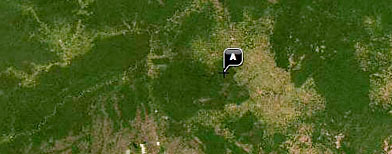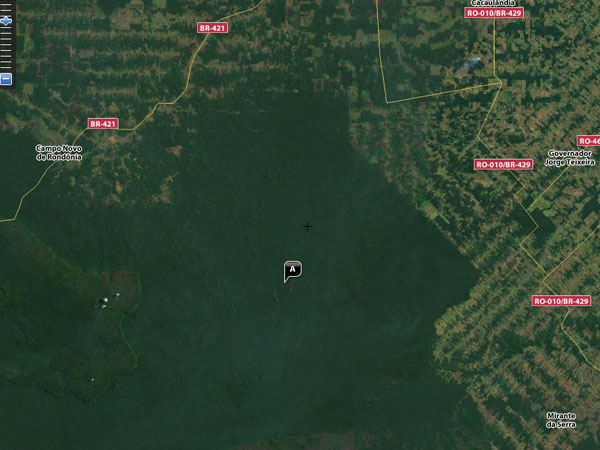 The Most Isolated Man on the Planet
The Most Isolated Man on the Planet
He’s alone in the Brazilian Amazon, but for how long?
The most isolated man on the planet will spend tonight inside a leafy palm-thatch hut in the Brazilian Amazon. As always, insects will darn the air. Spider monkeys will patrol the treetops. Wild pigs will root in the undergrowth. And the man will remain a quietly anonymous fixture of the landscape, camouflaged to the point of near invisibility.
That description relies on a few unknowable assumptions, obviously, but they’re relatively safe. The man’s isolation has been so well-established—and is so mind-bendingly extreme—that portraying him silently enduring another moment of utter solitude is a practical guarantee of reportorial accuracy.
He’s an Indian, and Brazilian officials have concluded that he’s the last survivor of an uncontacted tribe. They first became aware of his existence nearly 15 years ago and for a decade launched numerous expeditions to track him, to ensure his safety, and to try to establish peaceful contact with him. In 2007, with ranching and logging closing in quickly on all sides, government officials declared a 31-square-mile area around him off-limits to trespassing and development.
It’s meant to be a safe zone. He’s still in there. Alone.
History offers few examples of people who can rival his solitude in terms of duration and degree. The one that comes closest is the “Lone Woman of San Nicolas”—an Indian woman first spotted by an otter hunter in 1853, completely alone on an island off the coast of California. Catholic priests who sent a boat to fetch her determined that she had been alone for as long as 18 years, the last survivor of her tribe. But the details of her survival were never really fleshed out. She died just weeks after being “rescued.”
Certainly other last tribesmen and -women have succumbed unobserved throughout history, the world unaware of their passing. But what makes the man in Brazil unique is not merely the extent of his solitude or the fact that the government is aware of his existence. It’s the way they’ve responded to it.
Advanced societies invariably have subsumed whatever indigenous populations they’ve encountered, determining those tribes’ fates for them. But Brazil is in the middle of an experiment. If peaceful contact is established with the lone Indian, they want it to be his choice. They’ve dubbed this the “Policy of No Contact.” After years of often-tragic attempts to assimilate into modern life the people who still inhabit the few remaining wild places on the planet, the policy is a step in a totally different direction. The case of the lone Indian represents its most challenging test.
A few Brazilians first heard of the lone Indian in 1996, when loggers in the western state of Rondônia began spreading a rumor: A wild man was in the forest, and he seemed to be alone. Government field agents specializing in isolated tribes soon found one of his huts—a tiny shelter of palm thatch, with a mysterious hole dug in the center of the floor. As they continued to search for whoever had built that hut, they discovered that the man was on the run, moving from shelter to shelter, abandoning each hut as soon as loggers—or the agents—got close. No other tribes in the region were known to live like he did, digging holes inside of huts—more than five feet deep, rectangular, serving no apparent purpose. He didn’t seem to be stray castaway from a documented tribe.
 Eventually, the agents found the man. He was unclothed, appeared to be in his mid-30s (he’s now in his late 40, give or take a few years), and always armed with a bow-and-arrow. Their encounters fell into a well-worn pattern: tense standoffs, ending in frustration or tragedy. On one occasion, the Indian delivered a clear message to one agent who pushed the attempts at contact too far: an arrow to the chest.
Eventually, the agents found the man. He was unclothed, appeared to be in his mid-30s (he’s now in his late 40, give or take a few years), and always armed with a bow-and-arrow. Their encounters fell into a well-worn pattern: tense standoffs, ending in frustration or tragedy. On one occasion, the Indian delivered a clear message to one agent who pushed the attempts at contact too far: an arrow to the chest.
Peaceful contact proved elusive, but those encounters helped the agents stitch together a profile of a man with a calamitous past. In one jungle clearing they found the bulldozed ruins of several huts, each featuring the exact same kind of hole—14 in all—that the lone Indian customarily dug inside his dwellings. They concluded that it had been the site of his village, and that it had been destroyed by land-hungry settlers in early 1996.
Those kinds of clashes aren’t unheard of: Brazil’s 1988 Constitution gave Indians the legal right to the land they have traditionally occupied, which created a powerful incentive for settlers to chase uncontacted tribes off of any properties they might be eyeing for development. Just months before the agents began tracking the lone Indian, they made peaceful first contact with two other tribes that lived in the same region. One tribe, the Akuntsu, had been reduced to just six members. The rest of the tribe, explained the chief, had been killed during a raid by men with guns and chainsaws.
If you go to Rondônia today, none of the local landowners will claim any knowledge of these anecdotal massacres. But most aren’t afraid to loudly voice their disdain over the creation of reserves for such small tribes. They will say that it’s absurd to save 31 square miles of land for the benefit of just one man, when a productive ranch potentially could provide food for thousands.
That argument wilts under scrutiny, in part because thousands of square miles of already-cleared forest throughout the Amazon remain barren wastelands, undeveloped. The only economic model in which increased production absolutely depends on increased clearing is a strictly local one. The question of who’d benefit from clearing the land versus preserving it boils down to two people: the individual developer and the lone Indian.
The government agents know this, which is why they view the protection of the lone tribesman as a question human rights, not economics.
He eats mostly wild game, which he either hunts with his bow-and-arrow or traps in spiked-bottom pitfalls. He grows a few crops around his huts, including corn and manioc, and often collects honey from hives that stingless bees construct in the hollows of tree trunks. Some of the markings he makes on trees have suggested to indigenous experts that he maintains a spiritual life, which they’ve speculated might help him survive the psychological of being, to a certain extent, the last man standing in a world of one.
But how long can his isolation last? I get Facebook updates telling me what people half a world away are eating for breakfast. Corporations and governments are pushing deeper and farther than ever in search of bankable resources. How can it be that no one has flushed this man out already? In 2010, can anyone realistically live off the grid?
Some Brazilians believe that the rapid spread of technology itself might protect his solitude, not threaten it. The agents who have worked on the lone Indian’s case since 1996 believe that the wider the story of the man’s isolation spreads—something that’s easier than ever now—the safer he’ll be from the sort of stealthy, anonymous raids by local land-grabbers that have decimated tribes in the past. Technologies like Google Earth and other mapping programs can assist in monitoring the boundaries of his territory. Instead of launching intrusive expeditions into the tribal territories to verify the Indians’ safety, Brazilian officials have announced they will experiment with heat-seeking sensors that can be attached to airplanes flying high enough to cause no disruption on the ground.
I first heard of the lone Indian a little more than five years ago, when I was the South America correspondent for the Washington Post and was interviewing a man who headed the federal department responsible for protecting isolated tribes in the Amazon. He mentioned the man as an aside, giving me a rundown of the latest attempt to force contact with him—the expedition that ended with an agent getting shot in the chest with an arrow.
I traced a huge star and three exclamation points in the margin of my notebook as he moved onto another subject. Those flags—don’t forget to come back to this!—were pointless, because I couldn’t stop thinking about the lone man and those daredevil expeditions to contact him.
Now, what I keep coming back to is a little different: the lone man and the unprecedented restraint the agents are showing in choosing not to repeat history.
